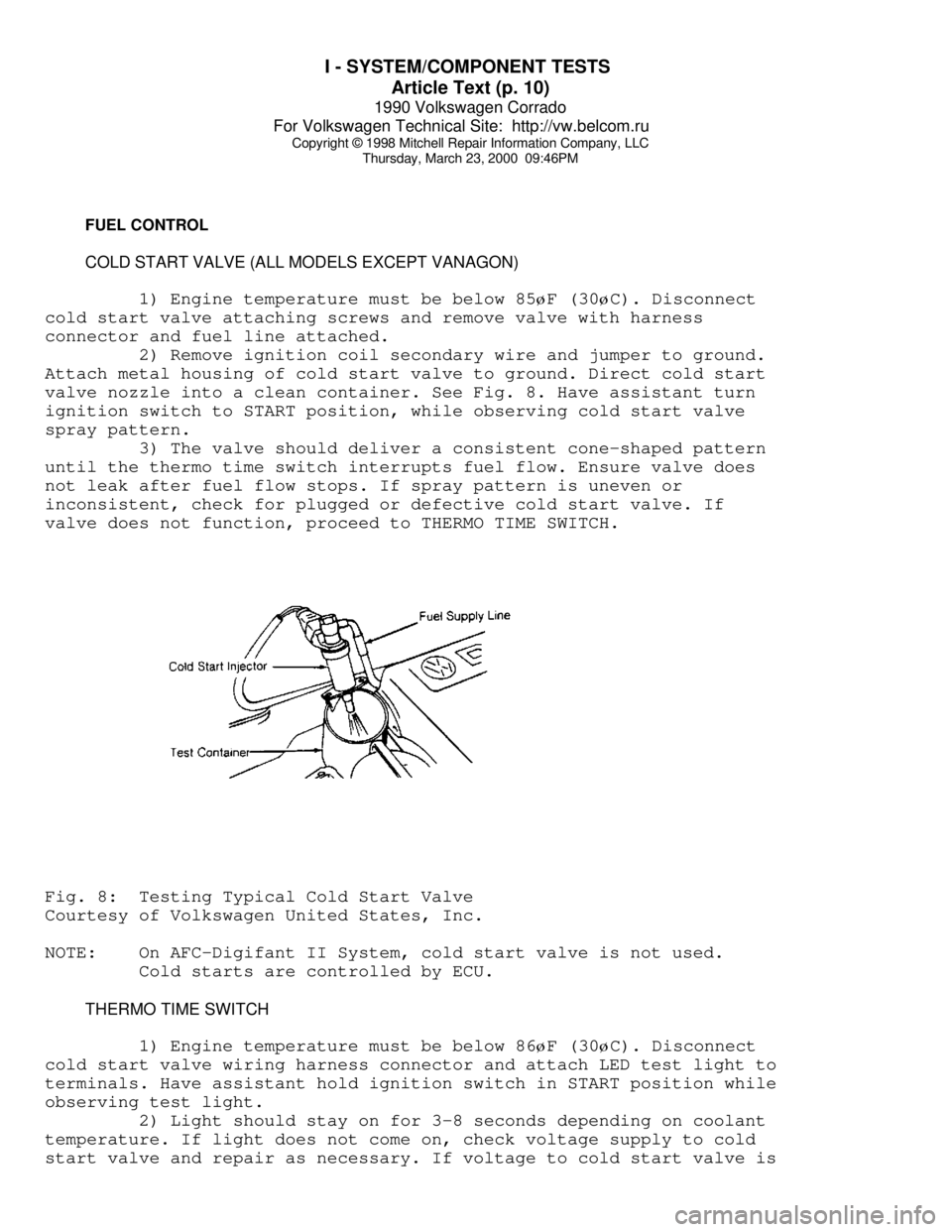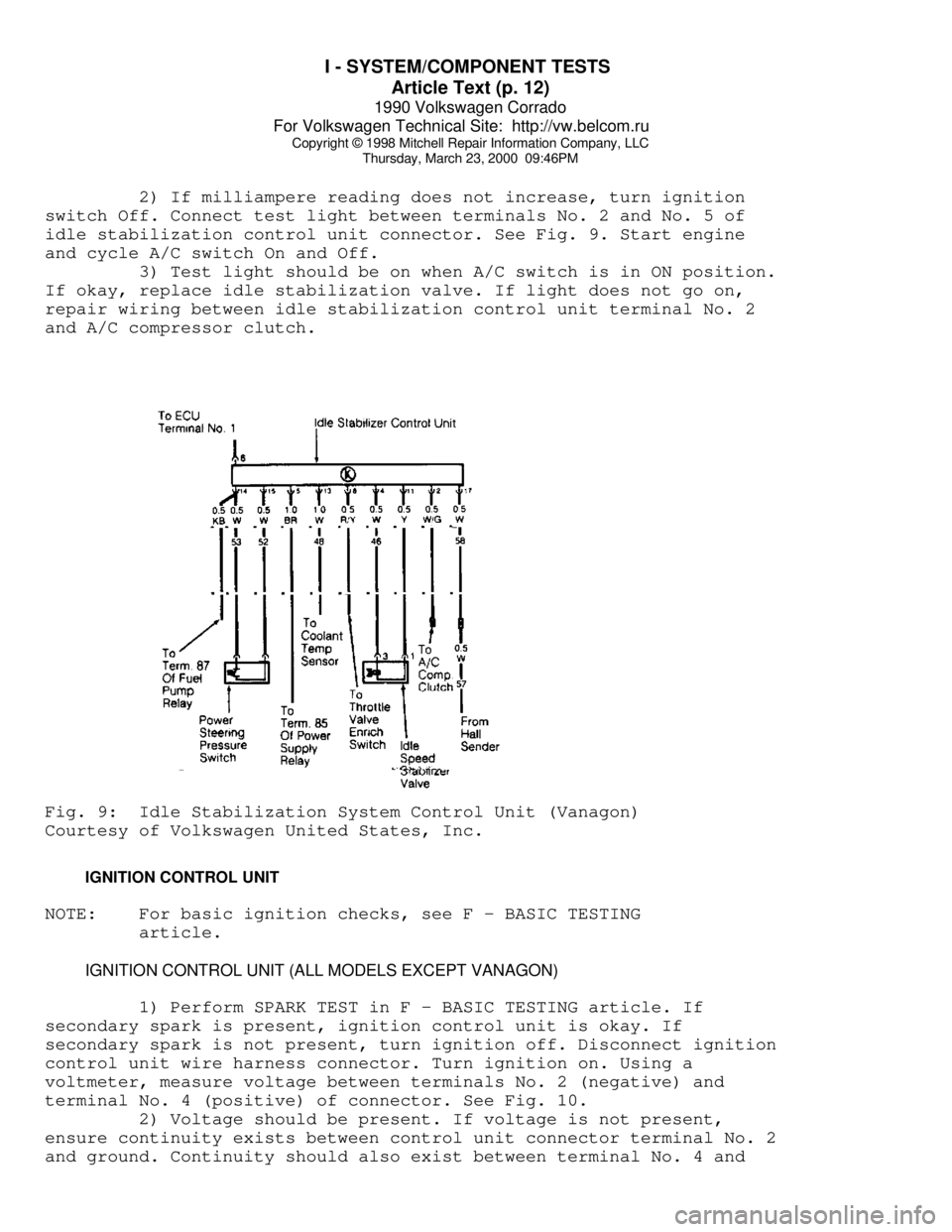1990 VOLKSWAGEN CORRADO engine
[x] Cancel search: enginePage 597 of 906

I - SYSTEM/COMPONENT TESTS
Article Text (p. 10)
1990 Volkswagen Corrado
For Volkswagen Technical Site: http://vw.belcom.ru
Copyright © 1998 Mitchell Repair Information Company, LLC
Thursday, March 23, 2000 09:46PM
FUEL CONTROL
COLD START VALVE (ALL MODELS EXCEPT VANAGON)
1) Engine temperature must be below 85øF (30øC). Disconnect
cold start valve attaching screws and remove valve with harness
connector and fuel line attached.
2) Remove ignition coil secondary wire and jumper to ground.
Attach metal housing of cold start valve to ground. Direct cold start
valve nozzle into a clean container. See Fig. 8. Have assistant turn
ignition switch to START position, while observing cold start valve
spray pattern.
3) The valve should deliver a consistent cone-shaped pattern
until the thermo time switch interrupts fuel flow. Ensure valve does
not leak after fuel flow stops. If spray pattern is uneven or
inconsistent, check for plugged or defective cold start valve. If
valve does not function, proceed to THERMO TIME SWITCH.Fig. 8: Testing Typical Cold Start Valve
Courtesy of Volkswagen United States, Inc.
NOTE: On AFC-Digifant II System, cold start valve is not used.
Cold starts are controlled by ECU.
THERMO TIME SWITCH
1) Engine temperature must be below 86
øF (30øC). Disconnect
cold start valve wiring harness connector and attach LED test light to
terminals. Have assistant hold ignition switch in START position while
observing test light.
2) Light should stay on for 3-8 seconds depending on coolant
temperature. If light does not come on, check voltage supply to cold
start valve and repair as necessary. If voltage to cold start valve is
Page 598 of 906

I - SYSTEM/COMPONENT TESTS
Article Text (p. 11)
1990 Volkswagen Corrado
For Volkswagen Technical Site: http://vw.belcom.ru
Copyright © 1998 Mitchell Repair Information Company, LLC
Thursday, March 23, 2000 09:46PM
okay, check ground circuit through thermo time switch. Replace thermo
time switch if contact to ground cannot be made.
IDLE CONTROL SYSTEM
NOTE: Knock control is integral in AFC-Digifant II ECU.
KNOCK SENSOR CONTROL UNIT (ALL MODELS EXCEPT VANAGON)
1) Check ignition coil and Hall Effect sender before checking
knock sensor control unit. Remove knock sensor control unit harness
connector. Turn ignition on. Using a voltmeter, check for battery
voltage between terminals No. 3 and No. 5 and terminals No. 6 and No.
3 of knock sensor control unit. Open throttle valve. Voltage should
drop to zero volts.
2) If voltage does not drop to zero volts, check throttle
valve switch (full throttle). Check voltage between terminals No. 8
and No. 3, while fully opening throttle valve. If battery voltage was
not present when throttle fully open, replace throttle valve switch.
See Fig. 13.
3) Remove Hall Effect sender connector and connect voltmeter
to outside terminals. Turn ignition on. There should be 5 volts
present. Turn ignition off. Connect voltmeter between terminals No. 1
(negative) and No. 15 (positive) of ignition coil. Turn ignition on
and touch center terminal of Hall Effect sender briefly to ground.
Voltage should jump momentarily to approximately 2 volts. If voltage
does not jump, replace knock sensor control unit.
KNOCK SENSOR(S)
Before replacing knock sensor, check knock sensor torque and
resistance. Remove knock sensor connector and check resistance between
terminals No. 13 and No. 14. See KNOCK SENSOR TORQUE & RESISTANCE
SPECIFICATION table. If resistance is incorrect, replace knock sensor.
NOTE: Knock sensor mounting bolt torque must be exact. DO NOT use
washers when mounting knock sensor.
KNOCK SENSOR RESISTANCE & TORQUE SPECIFICATIONÄÄÄÄÄÄÄÄÄÄÄÄÄÄÄÄÄÄÄÄÄÄÄÄÄÄÄÄÄÄÄÄÄÄÄÄÄÄÄÄÄÄÄÄÄÄÄÄÄÄÄÄÄÄÄÄÄÄÄÄÄÄÄÄÄÄÄÄÄÄApplication Resistance Ft. Lbs (N.m)
Type I ...................... 300,000 ................ 7-9 (10-12)
Type II .................... Infinite .............. 15-18 (20-25)
ÄÄÄÄÄÄÄÄÄÄÄÄÄÄÄÄÄÄÄÄÄÄÄÄÄÄÄÄÄÄÄÄÄÄÄÄÄÄÄÄÄÄÄÄÄÄÄÄÄÄÄÄÄÄÄÄÄÄÄÄÄÄÄÄÄÄÄÄÄÄ IDLE STABILIZATION SYSTEM (VANAGON)
1) Attach Test Meter (VW 1315/2) and Adapter (US 1119) to
idle stabilization valve. Set meter to milliampere scale. Start
engine. Observe test meter while turning A/C control switch to ON
position. If milliampere reading increases, system is okay.
Page 599 of 906

I - SYSTEM/COMPONENT TESTS
Article Text (p. 12)
1990 Volkswagen Corrado
For Volkswagen Technical Site: http://vw.belcom.ru
Copyright © 1998 Mitchell Repair Information Company, LLC
Thursday, March 23, 2000 09:46PM
2) If milliampere reading does not increase, turn ignition
switch Off. Connect test light between terminals No. 2 and No. 5 of
idle stabilization control unit connector. See Fig. 9. Start engine
and cycle A/C switch On and Off.
3) Test light should be on when A/C switch is in ON position.
If okay, replace idle stabilization valve. If light does not go on,
repair wiring between idle stabilization control unit terminal No. 2
and A/C compressor clutch.Fig. 9: Idle Stabilization System Control Unit (Vanagon)
Courtesy of Volkswagen United States, Inc.
IGNITION CONTROL UNIT
NOTE: For basic ignition checks, see F - BASIC TESTING
article.
IGNITION CONTROL UNIT (ALL MODELS EXCEPT VANAGON)
1) Perform SPARK TEST in F - BASIC TESTING article. If
secondary spark is present, ignition control unit is okay. If
secondary spark is not present, turn ignition off. Disconnect ignition
control unit wire harness connector. Turn ignition on. Using a
voltmeter, measure voltage between terminals No. 2 (negative) and
terminal No. 4 (positive) of connector. See Fig. 10.
2) Voltage should be present. If voltage is not present,
ensure continuity exists between control unit connector terminal No. 2
and ground. Continuity should also exist between terminal No. 4 and
Page 601 of 906

I - SYSTEM/COMPONENT TESTS
Article Text (p. 14)
1990 Volkswagen Corrado
For Volkswagen Technical Site: http://vw.belcom.ru
Copyright © 1998 Mitchell Repair Information Company, LLC
Thursday, March 23, 2000 09:46PM
terminals. Disconnect Hall Effect sender wire harness connector from
distributor. Turn ignition on.
2) While observing DVOM reading, attach center terminal of
connector to ground for 3 seconds. Voltage reading should briefly
increase to 4.5 volts. If voltage reading did not increase, check
wiring for short or open circuit. If wiring is okay, replace ignition
control unit.
EMISSION SYSTEMS & SUB-SYSTEMS
EXHAUST GAS RECIRCULATION (EGR)
1) With engine idling, apply about 12 in. Hg to EGR valve
with a hand-held vacuum pump. Engine should run rough or stall. If
idle does not change, remove EGR valve and inspect for restricted port
passage. Clean as required.
2) If port is clean, apply about 12 in. Hg to EGR valve with
vacuum pump. If valve does not move, replace EGR valve. If valve
moves, go to next step.
3) Install EGR valve and new gasket. Connect vacuum gauge to
EGR vacuum line with a "T" fitting. Start engine and increase engine
speed to about 3000 RPM. Vacuum gauge should indicate vacuum. If okay,
test is complete. If not okay, vacuum source is plugged. Repair as
necessary and repeat test.
FUEL EVAPORATION
EVAP CANISTER BY-PASS VALVE (ALL MODELS EXCEPT VANAGON)
1) Remove both vent hoses and vacuum hose from canister by-
pass valve. Apply very low air pressure to vent hoses individually.
There should be no airflow. If air passes through, replace by-pass
valve.
2) Attach vacuum pump to vacuum hose and apply 5-10 in. Hg.
Apply low air pressure to vent hoses individually. Valve should be
open and air should flow. If air does not flow, replace by-pass valve.
EVAP CANISTER BY-PASS VALVE (VANAGON)
1) Start and warm engine to normal operating temperature.
Disconnect White nylon hose from rubber boot at rear of intake
manifold. Attach vacuum pump and apply 5-10 in. Hg. If vacuum holds,
control valve is okay.
2) If vacuum does not hold, disconnect Purple vacuum hose
from throttle body. Attach vacuum gauge. If less than one in. Hg is
present, replace control valve. If more than one in. Hg is present,
adjust throttle valve stop screw and repeat test.
Page 607 of 906

INTERFERENCE VERIFICATION CHECK FOR OHC ENGINE
Article Text
1990 Volkswagen Corrado
For Volkswagen Technical Site: http://vw.belcom.ru
Copyright © 1998 Mitchell Repair Information Company, LLC
Thursday, March 23, 2000 09:46PM
ARTICLE BEGINNING
Maintenance & Service Information
1974-96 Volkswagen - Timing Belt Information
Cabrio, Cabriolet, Corrado, Dasher, Eurovan (Canadian), Fox,
Golf, Golf (Canadian), GTI, GTI (Canadian), Jetta, Jetta GLI,
Passat, Passat (Canadian), Pickup, Quantum, Rabbit, Scirocco,
Scirocco (Canadian), Transporter (Canadian), Vanagon
TIMING BELT INTERFERENCE VERIFICATION INFORMATION
TIMING BELT INTERFERENCE CAUTION
NOTE: CAMSHAFT DRIVE BELTS OR TIMING BELTS - The condition of
camshaft drive belts should always be checked on vehicles
which have more than 50,000 miles. Although some
manufacturers do not recommend replacement at a specified
mileage, others require it at 60,000-100,000 miles. A
camshaft drive belt failure may cause extensive damage to
internal engine components on most engines, although some
designs do not allow piston-to-valve contact. These designs
are often called "Free Wheeling". Many manufacturers changed
their maintenance and warranty schedules in the mid-1980's to
reflect timing belt inspection and/or replacement at
50,000-60,000 miles. Most service interval schedules shown in
this section reflect these changes. Belts or components
should be inspected and replaced if any of the following
conditions exist:
* Crack Or Tears In Belt Surface
* Missing, Damaged, Cracked Or Rounded Teeth
* Oil Contamination
* Damaged Or Faulty Tensioners
* Incorrect Tension Adjustment
TIMING BELT INTERFERENCE CHECK MENU
TIMING BELT INTERFERENCE VERIF. TABLE - PASSENGER CARS (1)ÄÄÄÄÄÄÄÄÄÄÄÄÄÄÄÄÄÄÄÄÄÄÄÄÄÄÄÄÄÄÄÄÄÄÄÄÄÄÄÄÄÄÄÄÄÄÄÄÄÄÄÄÄÄÄÄÄÄÄÄ Replacement Interval
Application Engine (Miles)
Cabrio
1995-96 .......... 2.0L 4-Cyl. ............ (3) 60,000
Cabriolet
1985-89 ....... 1.8L 4-Cyl. (DOHC) ........ (3) 60,000
1.8L 4-Cyl. (SOHC) ........ (3) 60,000
1990-93 .......... 1.8L 4-Cyl. ............ (3) 60,000
Corrado
1990-92 .......... 1.8L 4-Cyl. ............ (3) 60,000
Dasher
Page 608 of 906

INTERFERENCE VERIFICATION CHECK FOR OHC ENGINE
Article Text (p. 2)
1990 Volkswagen Corrado
For Volkswagen Technical Site: http://vw.belcom.ru
Copyright © 1998 Mitchell Repair Information Company, LLC
Thursday, March 23, 2000 09:46PM
1976-80 ..... (2) 1.5L 4-Cyl. Diesel ...... (3) 60,000
1974-80 .......... 1.6L 4-Cyl. ............ (3) 60,000
1981-80 ......... (2) 1.6L 4-Cyl.
Diesel & Turbo Diesel ...... (3) 60,000
Fox
1987-93 .......... 1.8L 4-Cyl. ............ (3) 60,000
Golf
1985-88 ..... (2) 1.6L 4-Cyl. Diesel ...... (3) 60,000
1985-89 ....... 1.8L 4-Cyl. (DOHC) ........ (3) 60,000
1985-93 ....... 1.8L 4-Cyl. (SOHC) ........ (3) 60,000
1990-92 .......... 1.8L 4-Cyl. ............ (3) 60,000
1993-96 .......... 2.0L 4-Cyl. ............ (3) 60,000
Golf (Canadian)
1985-92 ..... (2) 1.6L 4-Cyl. Diesel ...... (3) 60,000
1993 ............. 1.8L 4-Cyl. ............ (3) 60,000
GTI
1983-84 ..... (2) 1.6L 4-Cyl. Diesel ...... (3) 60,000
(2) 1.6L 4-Cyl. Turbo Diesel ... (3) 60,000
1.7L 4-Cyl. ............ (3) 60,000
1.8L 4-Cyl. ............ (3) 60,000
1985-89 .......... 1.8L 4-Cyl. (DOHC) ..... (3) 60,000
1983-92 .......... 1.8L 4-Cyl. (SOHC) ..... (3) 60,000
1990-92 .......... 1.8L 4-Cyl. ............ (3) 60,000
1990-96 .......... 2.0L 4-Cyl. ............ (3) 60,000
GTI (Canadian)
1993 ............. 2.0L 4-Cyl. ............ (3) 60,000
Jetta
1980 ............. 1.6L 4-Cyl. ............ (3) 60,000
1981-92 ........ (2) 1.6L 4-Cyl.
Diesel & Turbo Diesel ....... (3) 60,000
1983-84 .......... 1.7L 4-Cyl. ............ (3) 60,000
1.8L 4-Cyl. ............ (3) 60,000
1985-89 ....... 1.8L 4-Cyl. (DOHC) ........ (3) 60,000
1983-92 ....... 1.8L 4-Cyl. (SOHC) ........ (3) 60,000
1990-92 .......... 1.8L 4-Cyl. ............ (3) 60,000
1993-96 .......... 2.0L 4-Cyl. ............ (3) 60,000
Jetta GLI
1990-92 .......... 2.0L 4-Cyl. ............ (3) 60,000
Passat
1990-96 .......... 2.0L 4-Cyl. ............ (3) 60,000
Passat (Canadian)
1993 ............. 1.8L 4-Cyl. ............ (3) 60,000
Quantum
1981-86 ........ (2) 1.6L 4-Cyl.
Diesel & Turbo Diesel ....... (3) 60,000
1981-84 .......... 1.7L 4-Cyl. ............ (3) 60,000
1984-85 .......... 2.1L 5-Cyl. ............ (3) 60,000
1983-88 .......... 2.2L 5-Cyl. ............ (3) 60,000
1985-86 .......... 1.8L 4-Cyl. ............ (3) 60,000
Rabbit
1974-79 .......... 1.5L 4-Cyl. ............ (3) 60,000
1.6L 4-Cyl. ............ (3) 60,000
Page 609 of 906

INTERFERENCE VERIFICATION CHECK FOR OHC ENGINE
Article Text (p. 3)
1990 Volkswagen Corrado
For Volkswagen Technical Site: http://vw.belcom.ru
Copyright © 1998 Mitchell Repair Information Company, LLC
Thursday, March 23, 2000 09:46PM
1976-80 ..... (2) 1.5L 4-Cyl. Diesel ...... (3) 60,000
1981-84 ........ (2) 1.6L 4-Cyl.
Diesel & Turbo Diesel ....... (3) 60,000
1983-84 .......... 1.7L 4-Cyl. ............ (3) 60,000
1.8L 4-Cyl. ............ (3) 60,000
Scirocco
1976-79 .......... 1.5L 4-Cyl. ............ (3) 60,000
1976-80 .......... 1.6L 4-Cyl. ............ (3) 60,000
1983-84 .......... 1.7L 4-Cyl. ............ (3) 60,000
1.8L 4-Cyl. ............ (3) 60,000
1985-89 ....... 1.8L 4-Cyl. (DOHC) ........ (3) 60,000
1.8L 4-Cyl. (SOHC) ........ (3) 60,000
Scirocco (Canadian)
1989 .......... 1.8L 4-Cyl. (DOHC) ........ (3) 60,000
1.8L 4-Cyl. (SOHC) ........ (3) 60,000
(1) - Other interference engine applications may exist which
are not indicated here.
(2) - Interference engine. Check for possible damage to
piston(s) or valve(s) if there has been a timing belt
failure.
(3) - Although the vehicle manufacturer does not recommend a
specific scheduled maintenance interval, aftermarket
belt manufacturers suggest the belt be replaced at
60,000 mile intervals.
(4) - Vehicle manufacturer recommends replacing all belts at
the same time.ÄÄÄÄÄÄÄÄÄÄÄÄÄÄÄÄÄÄÄÄÄÄÄÄÄÄÄÄÄÄÄÄÄÄÄÄÄÄÄÄÄÄÄÄÄÄÄÄÄÄÄÄÄÄÄÄÄÄÄÄTIMING BELT INTERFERENCE VERIF. TABLE - LIGHT TRUCKS (1)
ÄÄÄÄÄÄÄÄÄÄÄÄÄÄÄÄÄÄÄÄÄÄÄÄÄÄÄÄÄÄÄÄÄÄÄÄÄÄÄÄÄÄÄÄÄÄÄÄÄÄÄÄÄÄÄÄÄÄÄÄ Replacement Interval
Application Engine (Miles)
Eurovan (Canadian)
1992-96 .......... 2.5L 5-Cyl. ............ (3) 60,000
Pickup
1980 ....... (2) 1.5L 4-Cyl. Diesel ....... (3) 60,000
1980-83 .......... 1.6L 4-Cyl. ............ (3) 60,000
1981-83 .... (2) 1.6L 4-Cyl. Diesel ....... (3) 60,000
1.7L 4-Cyl. ............ (3) 60,000
Transporter (Canadian)
1992-96 .......... 2.5L 5-Cyl. ............ (3) 60,000
Vanagon
1981-82 .... (2) 1.6L 4-Cyl. Diesel ....... (3) 60,000
(1) - Other interference engine applications may exist which
are not indicated here.
(2) - Interference engine. Check for possible damage to
piston(s) or valve(s) if there has been a timing belt
failure.
(3) - Although the vehicle manufacturer does not recommend a
Page 610 of 906

INTERFERENCE VERIFICATION CHECK FOR OHC ENGINE
Article Text (p. 4)
1990 Volkswagen Corrado
For Volkswagen Technical Site: http://vw.belcom.ru
Copyright © 1998 Mitchell Repair Information Company, LLC
Thursday, March 23, 2000 09:46PM
specific scheduled maintenance interval, aftermarket
belt manufacturers suggest the belt be replaced at
60,000 mile intervals.
(4) - Vehicle manufacturer recommends replacing all belts at
the same time.ÄÄÄÄÄÄÄÄÄÄÄÄÄÄÄÄÄÄÄÄÄÄÄÄÄÄÄÄÄÄÄÄÄÄÄÄÄÄÄÄÄÄÄÄÄÄÄÄÄÄÄÄÄÄÄÄÄÄÄÄEND OF ARTICLE